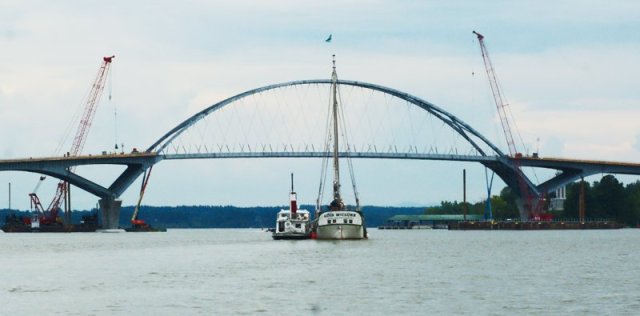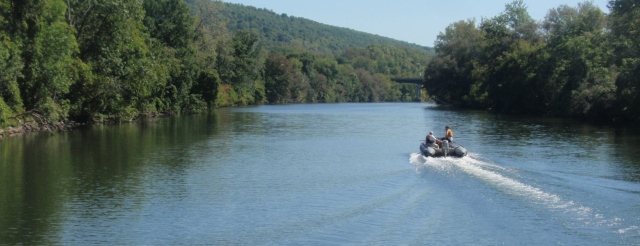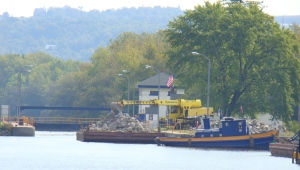by Jeff Gorss
THE VESSEL
It’s been variously referred to as a sailing canal boat, a canal schooner, a schooner, a canal boat, the boat, the ship, the Lois, and – of course – the Lois McClure. The Lois – a replica of a type of convertible cargo ship used in the mid and late nineteenth century – was launched in 2004. This sturdy craft was also my home for nine days in September.

THE OTHER VESSEL
The tugboat C.L. Churchill, the Lois McClure’s trusty sidekick, is literally attached to her hip for traveling in canals and rivers, a configuration that provides motive power and maximum control over the engineless schooner’s movement, especially in the locks. This 33’ faithful companion was built as a pleasure boat in 1964 and after being repurposed several times was donated to the museum in 2004 by Vermont’s Shelburne Shipyard.
THE OTHER OTHER VESSEL
One source I found defines “ooch” thusly: “to move or make something move cautiously or slowly”. The outboard powered inflatable Oocher often does just that, providing all manner of utility service, from a gentle nudge on the side of Lois in a lock to scouting ahead to sound the depth of an unknown harbor.

THE TOUR
The tour this year was the most ambitious mounted since the boat was launched in 2004. When it ends in mid October, this trip will have taken the Lois and her crew over 700 miles on Lake Champlain and eight different canal systems in two Canadian provinces and New York State, with a total of over forty stops in both provinces, New York, and Vermont. Like many of you, I followed the boat on its schedule by finding satellite images of the particular marina or canal wall where Lois was scheduled to tie up, and then zooming farther and farther out to eventually be able to see the entire extent of the tour. I was overwhelmed by the bigness – the audacity – of it. And now she’s on the home stretch – the eastern end of the Erie Canal, then the Champlain Canal, and – finally – back in Lake Champlain.
THE ROTATION AND TRAVELING
Every tour is divided into segments that are roughly a week long, at the end of which various types of supplies are taken to the boat by van from the museum. (We probably had less than a hundred pamphlets left by the end of my rotation, for instance, and the van brought thousands more.) This van also conveys a fresh group of volunteer crew members to the boat, and returns the previous week’s volunteers to the museum. My rotation began on a Thursday in Phoenix, NY, on the Oswego Canal, and ended in Little Falls nine days later. I had volunteered for that stretch because it included crossing Oneida Lake as well as other parts of the canal system I hadn’t traveled before.
After two days in Phoenix – approximately 150 fourth-graders the first morning and two public open houses – we cast off for Rome. The schedule allowed all day Sunday and all day Monday for roughly eight hours of actual travel time because, as nearly everyone who commented about traveling across Oneida Lake told us, “It can be treacherous” if the wind comes up when you’re only part-way across. Arriving at the west end of the lake Sunday morning, after only 2.5 hours of travel, Captain Roger Taylor considered the weather and made the decision to spend the rest of the day and that night in Brewerton, and begin crossing Monday morning. At 6 AM….

An excellent call, as the next morning’s sky was only partly cloudy and the wind dead calm. Heading east behind the tugboat C.L. Churchill, first on a short hawser until reaching the lake proper, we were treated to a clear night sky with the waning quarter moon overhead, midway between two bright objects quickly identified by Ian Montgomery with his smartphone as Jupiter and Venus.
Starting before dawn meant heading directly into the sun when it finally rose. While the lake’s north and south shores were visible throughout the crossing, east and west shores – more than 20 miles apart – are both below the horizon at mid-lake. Channel markers indicate the way across this shallow lake, including several permanently set on large concrete mounds near the middle. At the eastern shore, the tug returned to the schooner’s hip, and on we went in the canal to Rome. An uneventful crossing – the best kind.
THE PORTS OF CALL, AND LOCAL FOLKS
Phoenix was my first port of call, reached by road in the museum van. Phoenix is on the Oswego Canal, and some of the visitors to the Lois recalled the days when canal motor ship Day Peckinpaugh passed through carrying dry cement from Picton, Ontario to Rome, NY. A retired postal worker remembered delivering mail to the boat when it came through Lock O1 at Phoenix. Another visitor told how as a youth he and his band of buddies used to hang around the lock, watching boats go through. One day the captain of the Day Peckinpaugh called down to them, asked if they’d like to come aboard. The man said they couldn’t climb over fast enough, and from then on they made it a point to know the boat’s schedule and always be down by the lock when it came through.
Next port of call was Rome for public hours the following Tuesday, and, again, two visitors related personal experience with the Day Peckinpaugh – one had been a crewmember, and the other walked me up on a near-by bridge approach and showed me the concrete silos where the boat had unloaded, about half a mile east of where the Lois was tied up. On our way east the next day we could see remains of the moorings for the silos. We also saw where the ship turned around in what appeared to be the mouth of a stream but is actually the Mohawk River at one of many points where it flows out of the canal and meanders generally eastward, sometimes parallel, sometimes coincident with the canal.

The transit to Frankfort on Wednesday was uneventful and soon had us tied up to a solid old canal wall that the Town of Frankfort has incorporated into a waterfront park. The wall and the park lie beside a spur off the canal, at the point where the Mohawk River re-enters the canal (and pretty much stays with it from here on to the Hudson River). Frankfort was a busy manufacturing community in the nineteenth and early twentieth centuries and relied heavily on canal transportation.

One of the older versions of the Erie Canal ran – literally – right through the center of the village. C.L. Churchill captain Art Cohn and ship’s carpenter Kerry Batdorf discovered remains of a viaduct that carried it over Moyer Creek near – wait for it – Lock Street and West Canal Street. The next day, a helpful town assessor drove Art to another location east of the village where cut stones from the old canal lay along the old route. One of the most interesting aspects of traveling on the Lois is making connections like this with local people who share our interest and enthusiasm for the history of the locale.

The waterfront park includes several large grassy areas – perfect for introductory remarks to student groups and teachers about the boat and its mission, as well as Frisbee tossing for some of the crew. Best of all, for traveling boaters, is the array of shore facilities available – electricity, water, rest rooms, and showers.
After a good turnout of enthusiastic visitors for the public hours Thursday afternoon, we cast off Friday morning. Frankfort’s harbor is about twice as wide as the Lois is long, but Captain Taylor briskly and handily turned our close-coupled “flotilla” around and headed slowly north. With a blast on the Churchill’s air horn to warn traffic on the tree-lined canal of our approach, we swung into the main channel and headed east for Little Falls.

An otherwise uneventful transit threatened to become “interesting” as we approached Lock 18 – a Canal Corporation work barge was moored near the entry, making a zigzag approach necessary rather than the normal straight-in course. However, First Mate Tom Larsen cleanly jogged right as we passed the barge, then left to align us with the lock, making the difficult look easy. Not long after clearing the lock, we rounded a bend and entered the City of Little Falls. The wall in front of the Little Falls Rotary Park Marina had “No Parking” cones placed along the edge, waiting for Lois and her entourage, and a dozen or so citizens and local officials were on hand to greet us. Harbormaster Chris and other personnel at the marina can’t do enough to make the place clean, pleasant and welcoming. The building itself – which has the look of a former canal-side warehouse from the outside – includes a lounge for boaters, first-rate showers and bathrooms, and even a laundry facility.
Sadly, I was unable to enjoy Little Falls to the max, as Saturday was my last day on the Lois. After helping to unload supplies from the van and stow them aboard, I said good-bye to each of the wonderful members of the crew and headed home.
Special Thanks to:
- New York State Canal Corps
- Brian Swift
- Mayor Fusco
- Village of Frankfort
- Karlee Tamburro
- Bob Reina
- Ron Vivacqua
Jeff Gorss
A retired consulting engineer who lives near Saratoga Springs, NY, Jeff got a taste of “life on the canal” while renting a Lockmaster canal boat in 2010 with his wife, sister, and brother-in-law. He “discovered” the Lois McClure later that summer, and returned this year for his second season of volunteering on the schooner.

Great blog! Guess who’ll be asked to write more next year?
Pingback: Fort Plain | Lake Champlain Maritime Museum
Pingback: Fort Plain (Lois McClure)